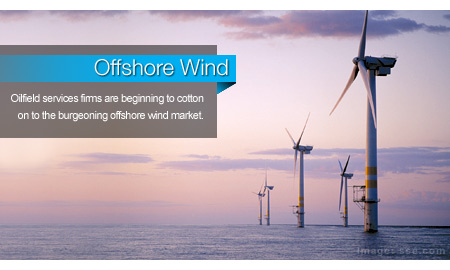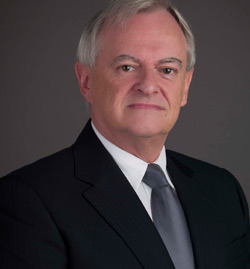Offshore Wind: an Opportunity for the Oilfield Services Industry

Since the late 1960s, the North Sea has been a major source of energy in the form of hydrocarbons for several countries, chiefly the United Kingdom and Norway.
But while some concern has been raised in recent years about how long North Sea oil can continue to support the Northern European oil and gas industry it has created, a whole new energy sector is taking off in the region where much of the experience and know-how that has been developed in the offshore oil sector is proving useful.
After the UK government announced plans in 2008 to open up the seas around Britain to enable the development of up to 33 gigawatts of offshore wind power by 2020, energy utilities have shown a great deal of interest in the sector. And they have invested heavily: firstly, in order to secure offshore wind development licenses awarded by the UK's Crown Estate; and, secondly, in the equipment and components required to construct offshore wind farms.
Meanwhile, other countries connected to the North Sea are getting in on the act. Denmark – actually a pioneer of the sector, having been involved in developing offshore wind farms since the 1990s – recently, in 2009, built a wind farm at Horns Rev (in the eastern North Sea) that was briefly the biggest offshore wind farm in the world. Not far away, further south, Germany is developing offshore wind schemes off its North Sea coast.
Opportunity "not being seized"
A key issue for the offshore wind industry is the obtaining of the logistical resources and knowledge required to install wind farms.

One man involved in helping to resolve this issue is Adrian Gillespie, Scottish Enterprise's Energy and Low Carbon Technologies Director. He is the author of a report published in September 2011 that highlighted the benefits of transferring know-how from the offshore oil and gas sector to the burgeoning offshore wind industry. This report stated that a cross-sector transfer of skills could reduce the development and operational costs of offshore wind farms by up to 20.1 percent.
"We felt that there was a huge opportunity here that maybe wasn't being seized," Gillespie told Rigzone, explaining that while there is "an awful lot of expertise within the oil and gas industry in a lot of relevant areas" the wind industry is "struggling with a lot of issues to do with the move to offshore".
"Indeed, there were issues cropping up in the early offshore wind farms that oil and gas expertise, had it been involved early on, might have been able to foresee and avoid," Gillespie said.
Although this was the key motivation for the Scottish Enterprise report, Gillespie said that there was also the realization from the offshore wind industry that the cost of offshore wind needs to come down and that there was an opportunity to draw on lessons already learned in the offshore oil and gas sector.
For example, the offshore wind sector needs to find the best ways to move personnel or to install such components as subsea cables and other subsea structures. "All of that expertise already existed in spades and there wasn't really the dialogue going on that would allow that expertise to transfer and also, at the same time, for the oil and gas companies to understand the potential of the offshore renewables market," said Gillespie.
Oilfield services firms targeting offshore wind
Despite Gillespie's view that there is much more that can be done to recruit offshore oil services expertise to facilitate offshore wind projects, there are a handful of long-established oil sector-focused firms that have already recognized the opportunity that offshore wind offers.
Gillespie himself points to Subsea 7 – the UK-based oilfield services business, whose shares are listed on the Oslo stock exchange. Subsea 7, which launched an offshore renewables division in January 2011, is supplying Scottish and Southern Energy its marine expertise to help with the construction of offshore wind farms using Siemens wind turbines.
Other oilfield services businesses that are targeting offshore wind include multi-billion dollar firms Petrofac, which bought fellow UK company TNEI (a renewables engineering consultancy) in June 2010, and Technip, France's major provider of project management, engineering and construction services to the oil and gas industry.
According to Technip vice-president for biofuels and renewable energies Stéphane His, the firm first began to realize that it could be involved in a "real transfer of know-how into a new market" after getting involved with Statoil's Hywind project in 2008. The Hywind project saw the installation of the world's first full-scale, floating offshore wind turbine located seven miles off the south-west coast of Norway.
Technip is also involved in a similar floating offshore wind turbine project in France, known as Vertiwind.
Meanwhile, the firm is working in partnership with Vattenfall Wind Power and Aberdeen Renewable Energy Group to establish Aberdeen's European Offshore Wind Development Centre – a scheme to install up to 11 next-generation offshore wind turbines.
His told us that there are plenty of activities that occur in installing offshore wind that are very familiar to oilfield services firms.
"When you think about the internal cable to the wind farm, this is pretty much what we do on a daily basis with umbilicals," His said, explaining that the kinds of cables that oilfield use for communications and to transmit power are very similar to the power cables that are used to connect up wind farms.
However, there is also a learning curve that oilfield services firms need to go through, particularly in the area of foundation installation.
"In offshore oil and gas, we have one very complicated operation and then we leave," His said. "In offshore wind when you install the wind turbine foundation and the wind turbine itself you have hundreds of installations to do. This is a very different way of thinking about how you are going to plan the work."
Keen to straddle both sectors
But offshore oil services firms like Subsea 7 and Technip are not the only oil businesses that are targeting the offshore wind sector.
In 2009, UK oil and gas explorer Ramco Energy reinvented itself as SeaEnergy specifically to take advantage of the offshore wind boom around Britain. Its original plan was to be a part-owner of offshore wind farms after successfully bidding, with then partner EDP Renováveis, for the rights to develop 1.3GW of wind farms in the Moray Firth, offshore Scotland.
More recently, SeaEnergy has reinvented itself again. After selling its 25-percent interest in the Moray Firth scheme, the firm raised around $40 million – part of which it is currently using to pursue plans to construct and operations and maintenance vessel that is aimed specifically at servicing offshore wind farms.
Meanwhile, the firm's management still appears keen to straddle both the oil and gas and the offshore wind sectors, since its legacy oil and gas investments means it retains interests in hydrocarbon exploration that is going on in the Celtic Sea off Ireland.
An entirely different scale
On an entirely different scale, Lamprell – the Dubai-based oil equipment company that specializes in the building, upgrading and refurbishment of jack-up rigs and other vessels for the oil industry – is now building vessels designed specifically to construct offshore wind farms

for the oil industry which is now building
vessels for the offshore wind sectorSource: lamprell.com
Lamprell Chief Executive Officer Nigel McCue said that around 20 percent of the firm's revenue is now represented by business from offshore wind customers.
"Most of the units are at the moment destined for the North Sea region. We have built, or are in the process of building, five vessels," McCue said. "We built two for SeaJacks, we're building a third one at the moment for SeaJacks and we're building two for the Fred Olsen Windcarrier group."
McCue explained that the Lamprell has a "great deal of expertise" in being a rig builder and jack-up constructor, with the firm being essentially the number one jack-up rig refurbisher in the Middle East. "So those are skills set that we have transferred over into the wind farm sector as well," McCue said.
Such expertise is essential when designing vessels for a harsh environment like the North Sea, according to McCue, who explained that an offshore wind vessel built by his firm will load with various components, including the wind turbine, and will sail under its own engines, hold on a course using directional positioning (DP) and then jack on location.
"They are complex vessels," McCue said. "They are self-propelled, they have DP and they have jacking so they are some of the more complex vessels that are built in the offshore market."
Clearly, there is indeed a big opportunity for firms used to supplying the needs of the oil and gas industry to grow a new market in offshore wind. But firms planning to service the offshore wind sector will still need to be prepared to learn new lessons along the way.
WHAT DO YOU THINK?
Generated by readers, the comments included herein do not reflect the views and opinions of Rigzone. All comments are subject to editorial review. Off-topic, inappropriate or insulting comments will be removed.
Rigzone
- ITEM Club: More Jobs Losses Expected in NE Scotland due to Oil Slump
- Shell Q&A: What Makes an Ideal Employer in Oil, Gas?
- Shell Takes First Place in Rigzone's Inaugural Ideal Employer Survey
- UK Government 'Must Recommit' to Oil, Gas Sector in Autumn Statement
- UK Government Gives Go-Ahead for Fracking in NW England
- How Likely Is an All-Out War in the Middle East Involving the USA?
- Rooftop Solar Now 4th Largest Source of Electricity in Australia
- US Confirms Reimposition of Oil Sanctions against Venezuela
- EU, Industry Players Ink Charter to Meet Solar Energy Targets
- Analyst Says USA Influence on Middle East Seems to be Fading
- Russian Ships to Remain Banned from US Ports
- Brazil Court Reinstates Petrobras Chair to Divided Board
- EIB Lends $425.7 Million for Thuringia's Grid Upgrades
- Var Energi Confirms Oil Discovery in Ringhorne
- Seatrium, Shell Strengthen Floating Production Systems Collaboration
- An Already Bad Situation in the Red Sea Just Got Worse
- What's Next for Oil? Analysts Weigh In After Iran's Attack
- USA Regional Banks Dramatically Step Up Loans to Oil and Gas
- EIA Raises WTI Oil Price Forecasts
- How Likely Is an All-Out War in the Middle East Involving the USA?
- Venezuela Authorities Arrest Two Senior Energy Officials
- Namibia Expects FID on Potential Major Oil Discovery by Yearend
- Oil Markets Were Already Positioned for Iran Attack
- Is The Iran Nuclear Deal Revival Project Dead?
- Petrobras Chairman Suspended
- Oil and Gas Executives Predict WTI Oil Price
- An Already Bad Situation in the Red Sea Just Got Worse
- New China Climate Chief Says Fossil Fuels Must Keep a Role
- Oil and Gas Execs Reveal Where They See Henry Hub Price Heading
- Equinor Makes Discovery in North Sea
- Macquarie Strategists Warn of Large Oil Price Correction
- DOI Announces Proposal for Second GOM Offshore Wind Auction
- Standard Chartered Reiterates $94 Brent Call
- Chevron, Hess Confident Embattled Merger Will Close Mid-2024
- Analysts Flag 'Remarkable Feature' of 2024 Oil Price Rally


